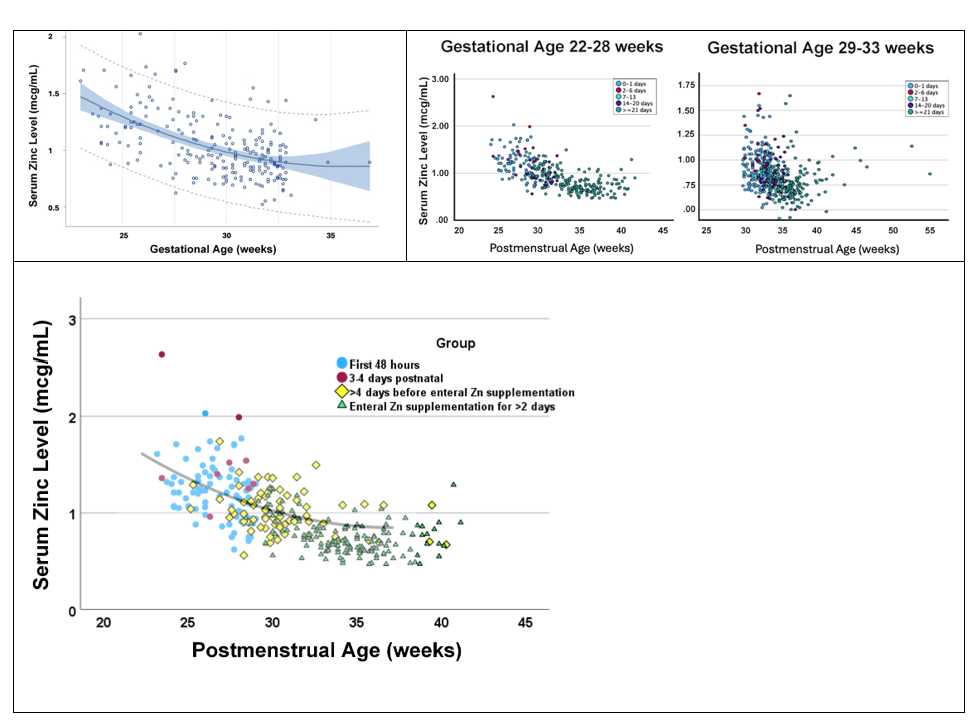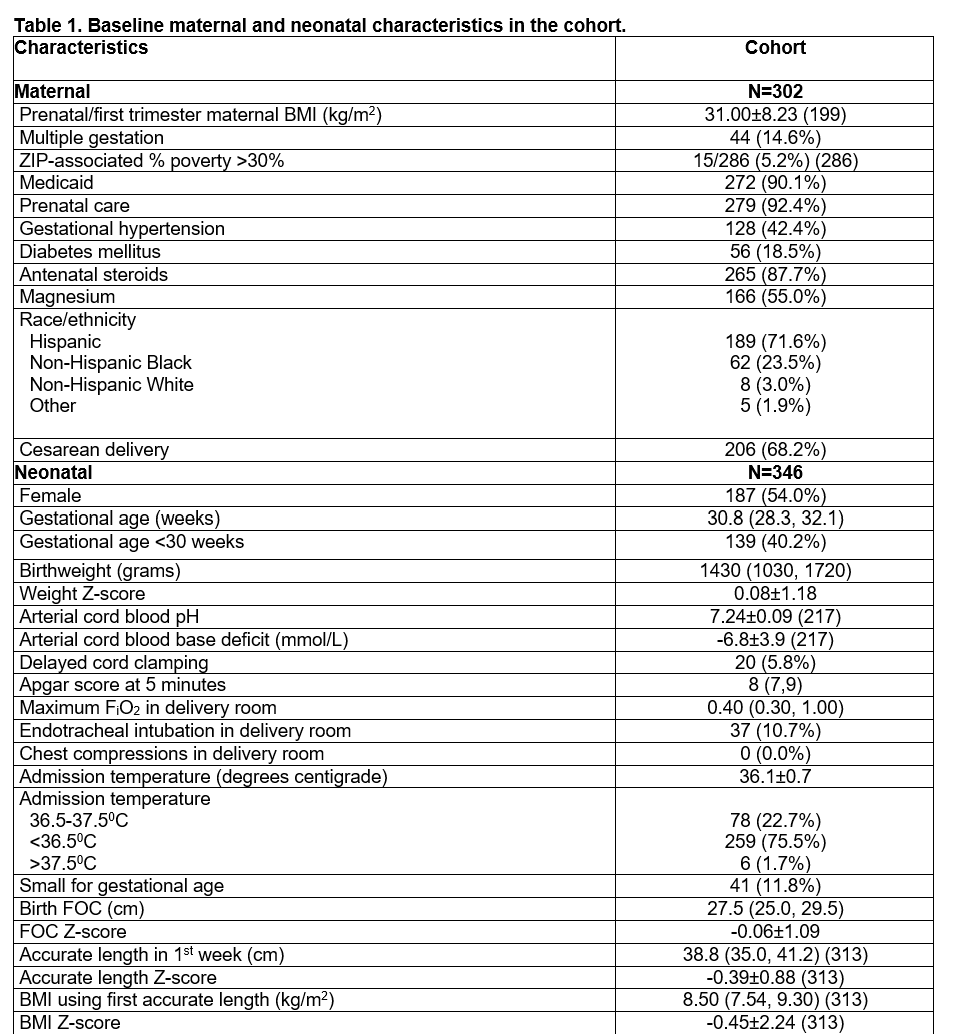Neonatal Fetal Nutrition & Metabolism 1
Session: Neonatal Fetal Nutrition & Metabolism 1
605 - Factors associated with late serum Zinc (Zn) levels in growing very preterm (VPT), <33 Weeks Gestational Age (GA) or Very Low Birthweight (VLBW, <1,500 g) newborns
Saturday, April 26, 2025
2:30pm - 4:45pm HST
Publication Number: 605.4756
Dimitrios Angelis, University of Texas Southwestern Medical School, Dallas, TX, United States; Tina A. Seidu, University of Texas Southwestern Medical School, Dallas, TX, United States; Roy Heyne, University of Texas Southwestern Medical School, Southlake, TX, United States; L. Steven Brown, Parkland Health, Dallas, TX, United States; Audrey Edwards, Parkland Health, Dallas, TX, United States; Cheryl S. Lair, Parkland Health & Hospital System, Arlington, TX, United States; Myra H. Wyckoff, UT Southwestern, Dallas, TX, United States; David B. Nelson, University of Texas Southwestern Medical School, Dallas, TX, United States; Luc (middle name P) P. Brion, University of Texas Southwestern Medical School, Dallas, TX, United States
- DA
Dimitrios Angelis, MD (he/him/his)
Neonatologist
University of Texas Southwestern Medical School
Dallas, Texas, United States
Presenting Author(s)
Background: Zn deficiency is frequently encountered in premature infants, since most of Zn accretion in the fetus occurs in the 2nd and 3rd trimesters. The gold standard method for definition of Zn deficiency is a serum Zn level below normative levels of 0.74-1.46 mcg/ml. Zn deficiency is indolent and can be associated with growth failure in preterm infants.
Objective: To describe the changes of serum Zn level with postnatal (PNA) or postmenstrual age (PMA) and assess factors that could be associated with Zn deficiency in a population of VPT/VLBW with routine Zn supplementation.
Design/Methods: As part of quality improvement initiative, targeting improved growth, 346 VLBW-VPT infants born at Parkland hospital between 01/2022 till 07/2023, received routine Zn supplementation [500 mcg/kg/day in TPN and routine enteral supplementation, to achieve a total of 2.5 mg/kg/day (increased to 2.7-3 mg/kg/day on 07/01/2022 based on new guidelines) until 36 weeks postmenstrual age (PMA) or discharge]. Early Zn levels were obtained within 48h postnatal; repeat Zn levels were obtained when the infant was at 140 ml/kg/day of feeds and one month later. Here, we place emphasis on repeat Zn levels, their progression with PNA or PMA and associations with various variables (enteral feeds, GA etc.). Statistical analysis included logistic regression analysis using SPSS and SAS.
Results: Baseline characteristics in this cohort are shown in Table 1. Early serum Zn levels decreased with GA (Figure 1a). Repeat Zn levels decreased with increasing GA, PNA and PMA and after starting feeds and enteral Zn supplementation (P < 0.001) (Table 2). Repeat serum levels within each GA stratum decreased with PMA (Figure 1b). Among infants < 29wks GA, repeat serum Zn levels during the first week of life and those obtained before enteral supplementation were similar to early levels when plotted against PMA (Figure 1b). In contrast, many repeat Zn levels obtained with enteral Zn supplementation for at least 2 days were lower than expected after 32wks PMA (Figure 1c). Serum Zn levels did not change significantly after increasing the routine dose of enteral Zn in July 2022.
Conclusion(s): Zn levels in VPT/VLBW appear to decrease further once the currently recommended enteral Zn supplementation was initialized when compared to early Zn levels of those on parenteral nutrition before starting enteral Zn supplementation. Since enteral absorption of Zn in premature infants is low, this could reflect differences in bioavailability. Further studies are needed with increased Zn dosing, given the importance of this micronutrient in growth and brain development.
Changes of early Zn with GA and subsequent Zn levels with growth.
 Figure 1a. Early Zinc levels (first 48 hours of life) by gestational age. 95% confidence and prediction intervals of first zinc concentration during the first 48 hours of life versus gestational age among infants <33 weeks gestational age or <1500 g birth weight, excluding those without congenital anomalies or comfort care only. Quadratic regression analysis. Adjusted R2=0.2921, n=228, P<0.0001. Equation: Zn = 5.63727 -0.26622 X GA +0.00370 x GA2. Abbreviations: Zn, serum zinc level; GA, gestational age (weeks)
Figure 1a. Early Zinc levels (first 48 hours of life) by gestational age. 95% confidence and prediction intervals of first zinc concentration during the first 48 hours of life versus gestational age among infants <33 weeks gestational age or <1500 g birth weight, excluding those without congenital anomalies or comfort care only. Quadratic regression analysis. Adjusted R2=0.2921, n=228, P<0.0001. Equation: Zn = 5.63727 -0.26622 X GA +0.00370 x GA2. Abbreviations: Zn, serum zinc level; GA, gestational age (weeks)Figure 1b. Serial serum zinc levels vs postmenstrual age and postnatal age by gestational age group in the growth cohort
Figure 1c. Serum zinc level versus postmenstrual age among infants <29 weeks gestational age.
Blue circles represent serum zinc levels within the first 48 hours postnatal while red circles represent levels at 3-4 days of life. Yellow diamonds show zinc levels at > 4 days of life before enteral zinc supplementation and green triangles represent zinc levels after >2 days of enteral zinc supplementation. The line shows the estimate from the quadratic regression analysis based on serum Zn levels within the 48 hours postnatal among all infants (Figure 2). Yellow diamonds are evenly distributed around the line, whereas many green triangles after 32 weeks postmenstrual age are below the line. Abbreviations; Zn, serum zinc level; GA, gestational age; PMA, postmenstrual age
Baseline maternal and neonatal characteristics in the cohort.
 The discrepancy between the number of maternal and neonatal characteristics corresponds to multiple pregnancies.
The discrepancy between the number of maternal and neonatal characteristics corresponds to multiple pregnancies.Values are mean ± SD (n if less than N in top row), median (IQR) (n if number < N in upper row) or number (%)
Abbreviations: BMI, body mass index; FiO2, fractional inspiration level of oxygen; FOC, fronto-occipital circumference.
Multivariable analysis of ranks of serum zinc levels by gestational age, postnatal age and enteral zinc supplementation prior to blood sampling
 Mixed model generalized linear equation by rank, 768 measurements among 352 neonates
Mixed model generalized linear equation by rank, 768 measurements among 352 neonates
